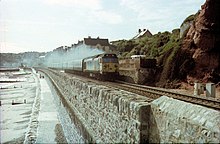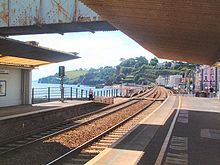Dawlish
| Dawlish | ||
|---|---|---|
| The quayside in Dawlish | ||
| Coordinates | 50 ° 35 ′ N , 3 ° 28 ′ W | |
| OS National Grid | SX963767 | |
|
|
||
| Residents | 11,312 (2011) | |
| administration | ||
| Post town | DAWLISH | |
| ZIP code section | EX7 | |
| prefix | 01626 | |
| Part of the country | England | |
| region | South West England | |
| Shire county | Devon | |
| District | Teignbridge | |
| Civil Parish | Dawlish | |
| British Parliament | Newton Abbot | |
Dawlish ( IPA : [ ˈdɔːlɪʃ ]) is a small town on the south coast of Devon , southern England , about 15 kilometers from Exeter.
Geographical location
Dawlish is located at the mouth of the small river Dawlish Water (also called The Brook ), between a red sandstone cliff and an upstream sandy bay. The latter is bounded by the "South Devon Railway sea wall", probably the most photographed railway retaining wall in the United Kingdom . The trains of the South Devon Railway Company have been running on this railway embankment since the turn of the year 1846/47 . The South West Coast Path runs along it . Behind the causeway, facing the city, is a small public park called The Lawn .
A scenic part of south-west England begins along the coast in a south-westerly direction and soon changes into the English Riviera . To the northeast, about 2 kilometers away, is the resort town of Dawlish Warren , which is connected by the beach promenade.
Dawlish is known for its black swans , which live along with other more exotic waterfowl on the lower reaches of Dawlish Water.
history
The first settlements are proven as early as before the birth of Christ, but they were above today's settlement area on the slopes of the surrounding hills. Its first inhabitants probably made a living from fishing and salt production. The place name has changed again and again over time. According to the oldest proven tradition, the name might have been Deawlisc . That means something like Devilwater, so devil's water. Further interpretations of names can be found in the Domesday Book .
The Danes raided the region around 800 AD , but left the place untouched. From 1050 until the 19th century, Dawlish was part of Exeter Cathedral .
With the opening of the railway line along the south coast by the South Devon Railway Company, a significant upswing began in the place. The townspeople came by rail and the place became a popular seaside resort .
traffic
The Dawlish train station located in the city center next to the beach. The trains departing here serve most stations in Devon and travel to London and far away. The route is one of the best known routes in England for its natural beauty, however, Network Rail's maintenance costs are among the highest of any route due to the constant efforts to combat coastal erosion . A storm in 1974 washed away a large part of the platform, and heavy swell during winter storms Nadja and Petra in February 2014 caused the breakwater to collapse and washed away a section of the railway line, leaving the tracks in the air. In this context, questions were raised as to what the vulnerability of the South Devon Railway Sea Wall in terms of storm damage, and suggestions were made to further lay the railway line to Plymouth inland, either by reopening the disused railway line on Okehampton and Tavistock , the reopening of the earlier Teign Valley Line or the revitalization of a 1930s project to build the Dawlish Avoiding Line .
The A379 runs parallel to the railway line through the town.
Town twinning
Since 1977 there has been a partnership with the approximately 250 kilometers south of the Breton town of Carhaix-Plouguer, which has a population of 7800 .
Dawlish in literature
Jane Austen spent a long vacation in Dawlish in 1802 and, years later, complained in a letter about the city's "particularly compassionate and poor library". She mentioned the city several times in her 1811 novel, Mind and Feel . In Charles Dickens ' novel Nicholas Nickleby (1838–39), the protagonist inherits a small farm near Dawlish. The writer Margaret Holford died on September 11, 1852 at the age of 84 in Dawlish.
Personalities
- Thomas Vowler Short (1790–1872), British clergyman and writer.
Web links
- Dawlish Town Council , official website (English)
Sources and References
- ↑ Black Swans and other waterfowl (Engl.) ( Memento of 12 July 2007 at the Internet Archive website), Dawlish Town Council
- ^ Railway cliff scheme 'on target' , BBC News. October 13, 2004. Retrieved March 31, 2008.
- ^ Weather could wash away rail link , BBC News. October 27, 2005. Retrieved March 31, 2008.
- ↑ Chris Ledgard: Brunel railway faces up to the sea (English) , BBC News. May 27, 2006. Retrieved November 20, 2016.
- ^ Peter Kay: Exeter-Newton Abbot: A Railway History . Platform 5, 1991, ISBN 1-872524-42-7 , p. 108.
- ^ Dawlish railway repairs halted over safety fears (English) , BBC News. October 13, 2004. Retrieved November 20, 2016.
- ↑ UK storms wash away railway line and leave Thousands without power (English) . In: BBC News , February 5, 2014. Retrieved November 20, 2016.
- ↑ Lauren Turner: How do you fix the Dawlish problem? (English) . In: BBC News , February 7, 2014. Retrieved November 20, 2016.
- ↑ British Towns Twinned with French Towns ( English ) Complete France. Retrieved November 20, 2016.
- ↑ Jane Austen… Dawlish and Sidmouth ( English ) Devon Libraries. Archived from the original on March 3, 2016. Info: The archive link was inserted automatically and has not yet been checked. Please check the original and archive link according to the instructions and then remove this notice. Retrieved December 19, 2016.
- ↑ Jane Austen Gazetteer - Sense and Sensibility - Dawlish, Devonshire ( English ) The Republic of Pemberley. Retrieved December 19, 2016.



